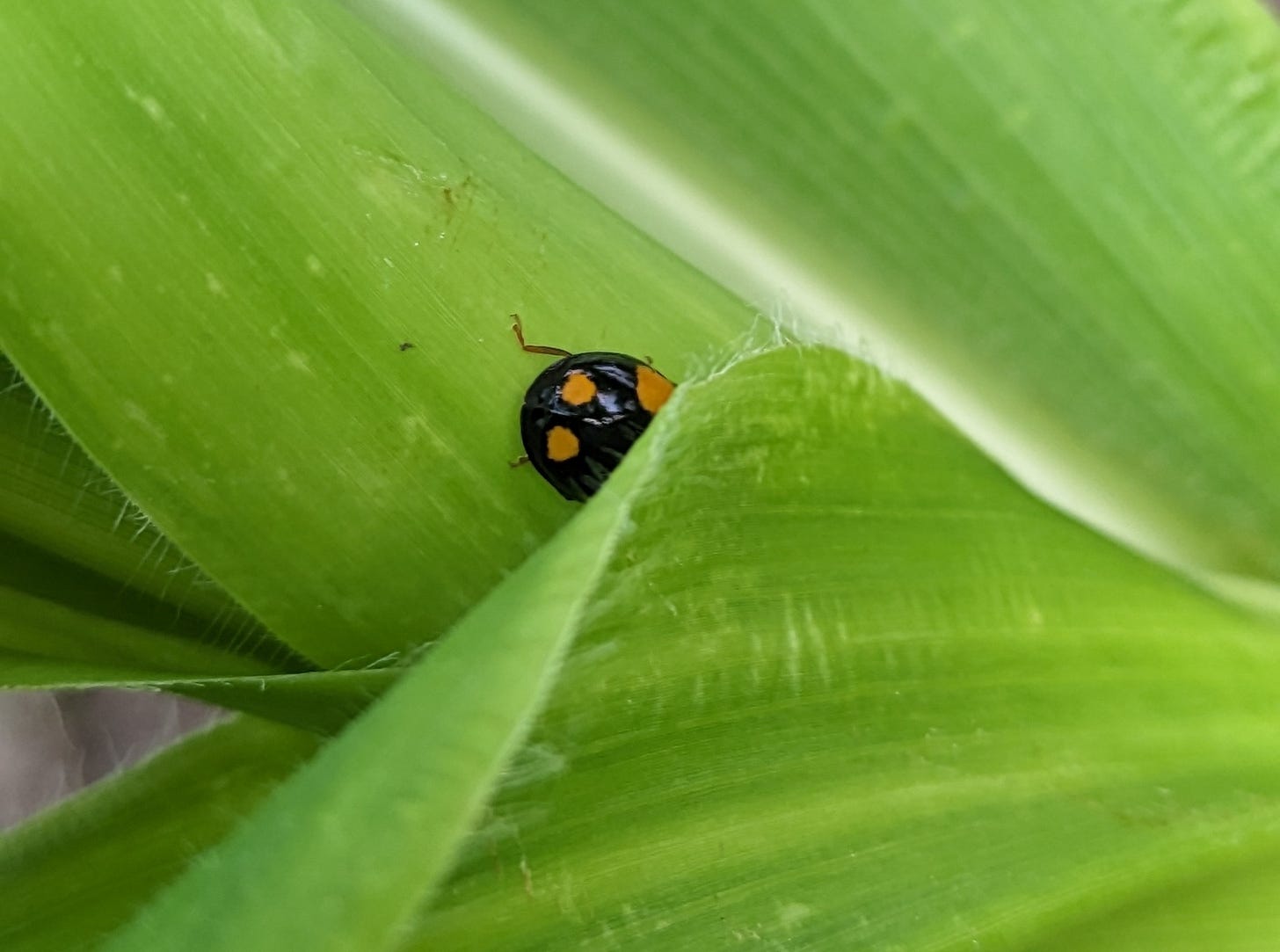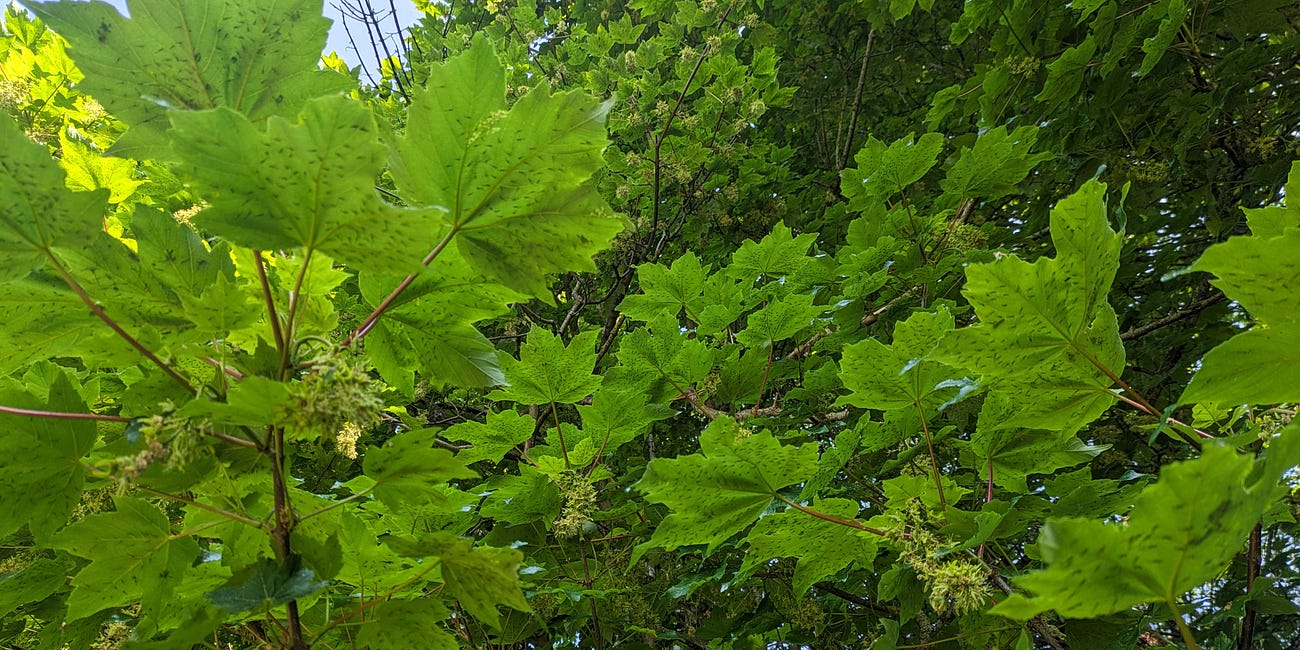I’ve been noticing ladybirds and their larvae more than ever this year - particularly on nettles and dock, possibly due to the hot weather in the UK. I’m very grateful for their presence at the allotment, where they do their best at keeping the aphids in check.
I won’t bang on about ladybirds too much, because:
I’d rather you went outside and looked for some ladybirds than stayed indoors and read my newsletter.1
Yes, ok, I also procrastinated for way too long today and ran out of time to write a compelling newsletter, what’s new?!
I came across this post by Mina this week, which is gorgeous, and better than the post I’d have written anyway… so you can just read her post:
I have, however, gathered some ladybird facts, which I hope you’ll enjoy…
Ladybird Facts
The collective noun for ladybirds is a loveliness!
The Scientific name for the ladybird family is Coccinellidae, derived from the Latin word coccineus, meaning ‘scarlet’. The word ‘ladybird’ is thought to have been inspired by early art featuring the Virgin Mary (known as ‘Our Lady’), who would appear wearing a red cloak.
There are 46 types of ladybird in the UK, although only 26 of these are recognisable as ladybirds. The rest are known as ‘inconspicuous’ and are often duller and smaller than their cousins (relatable, amiright?! OK, maybe that’s just me…). Worldwide, there are thought to be at least 3,500 different species of ladybird.
Ladybirds’ bright colouring is to warn predators that they’ll taste rank, though some birds still give snacking on ladybirds their best shot.
Ever picked up a ladybird and been left with a yellow substance on your hand? That’s the ladybirds’ other defence mechanism! It’s called ‘controlled bleeding’ or ‘reflex bleeding’ and that yellow stuff comes from their joints. Ladybirds are also very good at playing dead, which is my own preferred method of defence when having to get out of bed early.
Ladybirds are loved by gardeners because they eat aphids! You can encourage more ladybirds to your outside space by planting flat-topped flowers such as yarrow, fennel and dill or common companion plants like calendula, sweet alyssum and marigold.
Ladybirds overwinter (a bit like hibernating) from October to February. If you’re lucky enough to have a garden or balcony and grow plants with hollow stems, you can help ladybirds by not cutting back these plants until spring. You could also create a ‘ladybird hotel’ from a few pine cones bound together with twine or stuffing straw and a bundle of wide bamboo into an old pot and placing it in a sheltered spot.
Some of the ladybirds and larvae you come across are likely to be harlequin ladybirds (Harmonia axyridis), which are native to Asia and were first seen in the UK in 2004. OK, so these ladybirds are admittedly cannibals, and have been known to prey on smaller, UK-native ladybirds and their larvae/eggs, but disease and predators are bringing the population under control and they’re really nothing to worry about.
A few years ago there was a spate of articles that caused a right old fuss about harlequins invading our homes, biting humans and spreading STIS… The reality is that these ladybirds (and, while I’m at it, all ladybirds) are no threat to you and the chances of you being bitten are minuscule - just leave them be! If you find a ladybird in your home, you can try helping it find its way out by simply opening a window. If you have a gathering (sorry, I mean a loveliness) of ladybirds overwintering in your home and they’re causing you great offence, you could gently brush them into a box and pop them in a shed instead.
In my opinion, all those articles about harlequin ladybirds “wreaking havoc” actually wreak of anti-immigrant rhetoric and my guess is they were spread by pest control companies trying to make some money. Oh, and on the whole ‘harlequins can give you an STI’ thing: ladybirds can get a fungal infection (a bit like a sexually transmitted infection) called Hesperomyces virescens, but this only affects ladybirds. When asked if ladybirds could give this infection (which affects native ladybirds just as much as harlequins) to humans, Max Barclay, Senior Curator of Beetles at the Natural History Museum said: “That is ridiculous. It is a fungus that grows on the exoskeleton and we don't have one of these,” adding, “and we don't have sex with ladybirds”.
Sources & Further Reading
Woodland Trust: Ladybird ID
NatGeo Kids: Ladybird Facts
GrowVeg: Make Your Garden a Ladybird Paradise
Worcestershire Wildlife Trust: Lovely Ladybirds
The Wildlife Trusts: Harlequin Ladybirds
Discover Wildlife: Should We Be Scared of Harlequin Ladybirds? (spoiler alert: no)
Make Nature Zines with Me!
The Linnean Society invited me to lead a nature journaling walk and workshop this August - how lovely! Join me in central London on Thursday 28th August for a walk to St James’s Park, followed by a zine-making session at the Linnean Society. Book tickets and find out more here.
I’ll also be in Mote Park for a similar workshop run by Visit Maidstone on Saturday 19th July. More details and booking here.
You might also like…
Why is your car so sticky?
I accidentally went on a three-hour walk this week. I say “walk”, but if I’m honest I was standing still for a lot of it. Dazzingly pink hawthorn, a pair of regal swans, an impressively perfect guelder rose, a song thrush putting on a show… Everything is just so damn beautiful and green and floofy and distracting out there right now.
Remember to look, but not touch, unless you want yellow gunk left all over you!












A loveliness indeed! I've not seen so many ladybirds since the hot summer of 1976.
Harlequins may be problematic to other ladybirds, certainly in Edinburgh they seem to be taking over from other ladybird species in some places, which could be worrying.
The best places I know for hibernating ladybirds are cemeteries, specifically gravestones under trees,
Lol, "and we don't have sex with ladybirds".